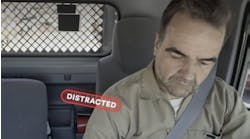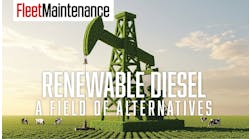Often, not much consideration is given to the venerable vehicle suspension and its important job of providing good ride, handling and control. This may sound like a simple task, but it is not. Many factors come into play that impact the suspension's proper operation.
Among the suspension's various functions: supports vertical loads - the vehicle's tare (empty) weight and when loaded; transfers loads from vehicle to ground via structural members, axles, wheels and tires; maintains axle and wheel position; provides compliance and isolation from road disturbances via springs and bushings for ride comfort and to maintain tire contact with the ground; and provides adequate stability and cornering stiffness for handling performance and safety. To do all this, the suspension must minimize frame movement and excitation, control vertical movement and lateral stiffness and provide damping to eliminate vibration and oscillation.
Because of the beating suspensions endure, components have a tendency to work themselves loose, tires can wear badly, springs can break, and so forth, causing increased repair costs, a loss of fuel economy and ride complaints from drivers among other things. Much of this can be avoided through proper and thorough suspension inspections and maintenance.
To get some guidance and advice on medium duty truck suspension care, Fleet Maintenance Magazine editor David A. Kolman turned to Hendrickson International, the leading supplier of truck, tractor, bus and recreational vehicle suspensions and springs; trailer suspensions, controls and non-integrated axles; truck and trailer lift axles; and bumpers and trim components.
REAR SUSPENSION
In addition to performing a periodic visual inspection on applicable components per the manufacturer's specification, Hendrickson advises checking for:
• Tire wear : Inspect tires for wear patterns that may indicate suspension damage or misalignment. Replace all worn or damaged parts. Verify proper alignment and correct as necessary.
• Wear and damage: Inspect all parts of the suspension for wear and damage. Look for bent or cracked parts. Replace all worn or damaged parts.
• Fasteners : Look for any loose or damaged fasteners on the entire suspension. Make sure all fasteners are tightened to a torque value within the specified torque range. Use a calibrated torque wrench to check torque in the tightening direction. Replace any worn or damaged fasteners.
• Clamp group: Check torque on clamp group mounting hardware. Refer to the manufacturer's torque specifications.
• Air spring (if equipped): Inspect air springs for chafing or any signs of air spring or component damage. Check the overall condition of the upper and lower air spring brackets for dents, dings, cracks or other damage. Replace all worn or damaged parts.
• Steel leaf spring: Look for cracks. Replace if cracked or broken. Check the front bushing for any wear or deterioration and replace if necessary.
• Crossmember and gussets: Inspect the crossmember and gussets for any signs of loosening or damage. Inspect the bar pin clamp blocks for any signs of looseness or movement. Check all fasteners for proper torque. Replace all worn or damaged parts.
• Frame hanger: Inspect the frame hanger bracket for any signs of loosening or damage. Inspect all fasteners securing the frame hanger bracket to the frame rails, as well as the longitudinal torque rod mounting fasteners. Check all fasteners for proper torque. Replace all worn or damaged parts.
• Height control valve and air lines (if equipped): Check the suspension air system for air leaks. Check all air lines for proper routing and for chafing or pinched areas. Check the height control valve linkage for damage or interference with peripheral components. Replace all worn or damaged parts.
• Shock absorbers: Look for any signs of dents or leakage. Misting is not considered a leak. Misting is very small amounts of shock fluid that evaporate at a high operating temperature through the upper seal of the shock.
• Top pad and rubber axle stop: Look for cracks and/or missing rubber axle stops. The rubber axle stop is exposed to contact forces in extreme jounce conditions. It will be necessary to visually inspect the rubber axle stop for wear at the specified inspection interval.
• Torque box (equipped on Hendrickson HTB suspensions): Inspect the torque box for cracks, damage, torn or shredded rubber or any signs of looseness at the bar pin clamps. Replace all worn or damaged parts. The torque box is a non-serviceable item and must be replaced as an assembly if damaged, or if the bushings are worn out.
• Torque rods: All torque rods must be inspected for looseness, torn or shredded rubber, bushing walk-out and proper fastener torque. If there is metal-to-metal contact in the bushing joint, this is a sign of excessive bushing wear and the bushing needs to be replaced.
FRONT SUSPENSION
Here again, Hendrickson recommends a periodic visual inspection, per the manufacturer's specification, plus checking for the following:
• Tire wear: Inspect tires for wear patterns that may indicate suspension damage or misalignment. The leading causes of tire wear are, in order of importance: tire pressure, toe setting, thrust angle and camber.
• Wear and damage: Inspect all parts of suspension for wear and damage. Look for bent or cracked parts. Replace all worn or damaged parts.
• Fasteners: Look for any loose or damaged fasteners on the entire suspension. Make sure all fasteners are tightened to the specified torque. Use a calibrated torque wrench to check torque in a tightening direction. Correct the torque if necessary. Replace any worn or damaged fasteners.
• Steel leaf spring: Look for cracks. Replace if cracked or broken. Check the front bushing for any wear or deterioration. Replace if necessary.
• Air spring (if equipped): Look for chaffing or any signs of spring or component damage.
• Front and rear spring hangers: Check for excessive movement. Check for cracks or loose mounting hardware and replace if necessary.
• Thrust washers and rear hanger clamp: Look for any signs of excessive wear to the thrust washers and rear hanger clamp.
• Rear spring mount: Check for proper alignment with spring taper and check for proper torque on rear spring mount fasteners.
• Shocks: Look for any signs of dents or leakage. Misting is not considered a leak.
• Clamp group: Check torque on clamp group mounting hardware. Refer to the manufacturer's torque specifications.
• Top and bottom axle wrap liners: Look for any cracking or broken pieces on liners.
• Axle: The axle should be free of any nicks or gouges. Inspect for any cracks or dents.
• Steering pivot points: Check for looseness at all pivot points.
• Operation: All steering components must move freely through the full range of motion from axle stop to axle stop.
RECOMMENDED MAINTENANCE
Preventative maintenance for front and rear suspensions should include the following, counsels Hendrickson.
• Fasteners: Look for any loose or damaged fasteners on the entire suspension and axle assembly. Check for any component slippage or weeping rust trails. Make sure all fasteners are at required torque. Replace any worn or damaged fasteners.
• Shock absorbers: Check all mounting hardware for correct torque. Inspect for leaks. Fluid streaming from the upper seal is a leaking shock and needs to be replaced (misting is not considered a leak). Perform heat test. Check for internal failure. Check for damage, which could include damaged upper or lower mount, damaged upper or lower bushing, damaged dust cover and/or shock body, bent or dented shock and improper installation.
• Clamp group (U-bolt/hex bolt): Clamp group should be properly aligned and bolts properly seated. Re-torque clamp group locknuts periodically per the manufacturer's recommendation. If signs of movement are present, disassemble the clamp group. Inspect for component wear or damage and replace as necessary.
• Ride height checking procedure (air suspensions only): Ride height setting - measured from the bottom of the upper air spring bracket to the bottom of the air spring piston flange - will vary between suspension models. (Ride height gauges are available for most Hendrickson air suspensions.): Ride height front and rear must be correctly set prior to checking vehicle alignment.
• Lubrication: Do periodic lubrication per the manufacturer's recommendations. Adjust the grease interval to accommodate application and environment. Use multipurpose grease. Refer to lubricant manufacturer's specifications for temperature service limits applicable to your area. Grease component until a clean grease purge is observed.
For front suspensions, Hendrickson says there also needs to be preventative maintenance on the steering knuckle thrust bearings, of which there are two different designs: composite bearing installed on left side, and roller bearing installed on the right side. For these, the lubrication must be performed with the axle in the loaded condition. Clean all grease zerks and the grease gun tip before applying grease. Fresh grease must purge on both thrust bearings
FRONT INSPECTION
The inspection procedure for front suspensions also consists of the following steps, says Hendrickson.
• Tie rod ends:
Nut - Verify that it is tight and the cotter pin is in place. If loose, remove and inspect mating parts. If no damage is found, re-install and torque to specs, and install a new cotter pin.
Seal - It must be free of tears and cracks. Replace the tie rod end if any damage is found. Boots must be in place and installed over the tie rod ends.
Zerk - Verify proper installation. If damaged or missing, replace the tie rod end.
• Tube/end connection: Check for loose tube/end connections. Replace either end. If loose, replace the assembly.
• Tube and clamps: Check for road damage and replace if damage is found. Check the clamps and replace if damaged or loose. Position the clamps so they don't interfere with the axle.
• Slot: Verify that the tie rod end is installed deeper than the slot. If the slot is open, replace the tie rod end with proper length.
• Tie rod rotation: Block rear wheels of vehicle and raise the front end off the ground and support with stands. With the engine must off, turn the wheels from full left to full right and return to the straight-ahead position. Rotate the cross tube by hand, or with a jaw protected pipe wrench, toward the front and then toward the rear and center cross tube. If the cross tube will not rotate in either direction, replace both tie rod ends.
• Vertical tie rod end play: Apply approximately 100 pounds of hand force in a push/pull type action to the underside of the tube near the tie rod end. Use hand pressure only, no prybars. If endplay is observed, recheck using a dial indicator. Note: Tie rod ends must always be replaced in pairs, and always grease tie rod ends following an inspection.
• Thrust washers: Inspect for excessive wear at regular inspection intervals. Look for excessive side-to-side movement of the spring or suspension. Check spring taper for contact with the rear hanger. Minimum allowable thickness of thrust washer will vary by suspension model. Replace in sets if worn on one side. Inspect rear hanger or shackle for damage
To inspect the king pin busing, Hendrickson says unload axle. Move the top of the tire in and out by applying reasonable constant pressure, then release. If movement is felt, apply the service brake and repeat. If movement is still present, install a dial indicator on the knuckle and repeat. Movement of more than 0.015 inches indicates worn king pin bushings.
King pin bushings preventative maintenance involves inspection with a dial indicator. Attach it to the axle and zero the indicator. Move the top of tire in and out by hand. A reading of more than 0.015 inches requires bushing replacement. If the upper bushing is within spec, then typically the lower is within spec. Both bushings must be replaced in sets.
As part of the preventive maintenance for the Hendrickson SteerTek front axle suspensions, which have axle wrap liners to prevent any type of abrasion at the axle clamp area, the liner should be replaced any time the axle wrap is removed. If the liner is cracked and all the pieces are intact, it is not necessary to replace the liner. If the liner is broken out and there are pieces missing, the liner must be replaced immediately.
LIFT AXLES
For lift axles, Hendrickson recommends a monthly inspection of shock absorbers for leaks and coil spring integrity where applicable, as well as a monthly general overview-type inspection of axle and suspension components. Every three months, king pin bushings and tie rod end connections should be greased. An inspection of toe setting on the axles should be conducted every six months.
On an annual basis, there should be an annual inspection of hardware torque per application and bushings and wear pads, along with a check of wheel play.
Hendrickson Auxiliary Axle Systems is introducing the new Composilite SC family of lift axles for steerable applications. It is the first compliant tie rod (CTR) assembly and dampening system with PerfecTrak technology, designed to help lower maintenance costs and increase uptime by providing a resilient, impact resistant tie rod assembly.
VEHICLE ALIGNMENT
No matter the type of suspension, its operation is affected by the vehicle's alignment. Proper attention to alignment - making sure the vehicle tracks straight and true - helps maximize tire life and can help increase fuel economy. There are basically three main elements to alignment: caster, camber and total toe, says Hendrickson.
Camber is the angle formed by the inward or outward tilt of the wheel in reference to a vertical line. Camber is non-adjustable, and bending should not be attempted, Hendrickson emphasizes. If the camber is found out of specifications, the manufacturer should be notified. Refer to the appropriate suspension technical publication for axle alignment specifications.
Caster is the forward or rearward tilt of the steering axle kingpin in reference to a vertical line. Proper caster is important for directional stability and returnability.
Ride height, front and rear, is a direct influence on caster, says Hendrickson. Low ride height means low caster. High ride height is high caster. Total caster is adjustable. There are industry standards for caster wedges. If cross caster is found out of specifications, notify the manufacturer.
Total toe is the angle formed by two horizontal lines through the planes of two wheels. Steer axle toe is adjustable. Properly adjusted toe reduces wear to the leading edge of the tire and avoids road wander, Hendrickson says. Use industry standard toe adjustment procedures.
All PM items and their descriptions can be found in the technical publications found on the Hendrickson website: www.hendrickson-intl.com. All information can be downloaded or ordered for no charge.



